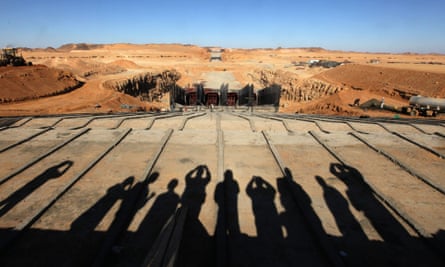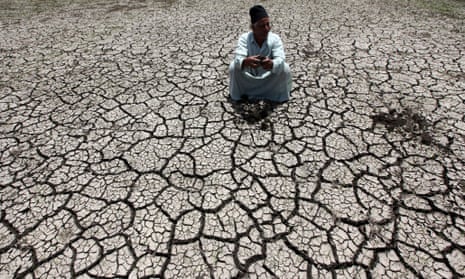On a blazing hot summer day, rumours that the water truck is finally arriving spread like wildfire through the village of Ezbit al-Taweel. In minutes, some 100 men, women and children pour onto the town’s main road, each with as many containers as they can carry.
Trying to escape the punishing sun, Osama Sayed and his seven-year-old son, Ahmed, take shelter beneath a bush. “It’s like we’ve travelled back in time, having to wait with jars for the water carrier,” says Sayed. Severe water cuts have repeatedly forced him and the 5,000 other farmers living in this small Nile Delta village to wait hours, sometimes even days, for drinking water, amid a severe heatwave in the Middle East.
Half an hour later the truck finally appears, to the palpable relief of the crowd. “There will be enough for everyone,” promises an elderly driver. “Organise yourselves and separate men from women.” Two workers begin distributing the water, while another collects money from the villagers.
Egypt, once celebrated as the “gift of the Nile”, is in the grips of a serious water crisis. With a rising population and a fixed supply, the country has less water per person each year.
The country’s annual water supply dropped to an average of 660 cubic metres a person in 2013, down from over 2,500 cubic metres in 1947, according to official figures. Egypt is already below the United Nations’ water poverty threshold, and by 2025 the UN predicts it will be approaching a state of “absolute water crisis”.
For people like Sayed, living in villages and cities outside of Egypt’s centres of power and wealth, that crisis has already arrived.
In June, the Delta city of Bilqas, with a population of 50,000, was suffering from a severe drought. “We can’t find water to drink, wash, clean or anything. We woke up to find we have moved to the desert and our taps are dry,” said Hossam Megahed, a city resident.
The same week, the city of Fayoum suffered a water cut so severe that even hospitals found themselves dry. A few days later, residents in Ismailia threatened to cut off the commercial highway from the Suez Canal after living for a week without water. Similar crises have struck Kafr al-Sheikh, Sohag, Qena and other cities throughout the summer.
Despite the magnitude of the problem, critics say the government has taken little action to resolve the crisis, or even to help ease the suffering of those most affected.

Why now?
Water shortages – and the unrest they cause– are making headlines in Egypt, but the problem has been building since 2011. Amid the security vacuum that emerged following the 2011 revolution, thousands of residents on the peripheries of Cairo and other cities began illegally constructing buildings and linking them up to the official supply pipes. Tens of thousands of new pipelines have tapped into water supplies that barely suffice for the citizens already there.
To make matters worse, when people illegally connect their homes to makeshift pipelines they tend to break and waste resources.. According to a 2014 report by the Egyptian Centre for Economic and Social Rights, as much as 35% of all residential water leaks into the ground because of the deteriorating pipe network. Without this wastage an additional 11 million inhabitants could have fresh water.
Meanwhile, Egyptian officials bogged down by the post-revolution turmoil have done little to correct the problem. “The issue of water is that it is not a priority to the government,” said Khaled Wasif, spokesperson for the Ministry of Irrigation and Water Resources. Only a fraction of the money needed to maintain the network is actually allocated each year by the government, he said.
The company that operates and maintains the network of pipes, the Holding Company for Water and Wastewater, , has been so under-funded in recent years that it cannot properly carry out its functions, according to an inside source.
Without enough money, water sector projects have been put on hold, except for a limited number financed by foreign donors. In a vicious cycle, this pushes more people to resort to illegal DIY solutions that cause the grid to deteriorate faster.
Shortages can last for a few hours a day in upscale districts such as New Cairo, a few days in villages like Ezbit el-Taweel, or as long as five years in some rural areas such as Sandub in Mansoura, where residents have grown accustomed to receiving water for only two hours a day.
When taps go dry, residents have little recourse except a ruthless black market. People in villages with water will often load tanks onto trucks and transport them to nearby residents in need – for a price.
Residents in Belqas said the price of bottled water increased every day from the beginning of Ramadan. As dozens of people waited in lines outside shops and kiosks, the price of a 1.5 litre bottle jumped from three pounds to 10 pounds within days.

Health hazards
Egyptians facing dwindling stocks have often resorted to unsanitary measures to fill the gap, often with serious health consequences.
“I live in Kafr al-Sheikh. I grew up knowing the water is highly polluted,” said Mohamed Abdel Razik, professor of water chemistry at the local university. The current water treatment process is like “using a fishing net to sanitise water”, he said.
In areas such as Ezbit al-Taweel, water bought from trucks is often heavily contaminated. Farmers looking to make a quick profit often transport liquid in tanks normally used to carry gas. These trucks are filled from the most convenient source, which can often be a nearby wastewater canal.
“We know very well that this water is coming from the nearest polluted source, but we have no other alternative,” said Sayed.
Wastewater canals are awash with agricultural runoff filled with dissolved fertilisers and pesticides, and make a rich habitat for pathogens such as bilharzia. Heavy metals such as mercury, arsenic, carcinogenic cadmium and lead have also been detected in high concentrations. Kafr al-Sheikh, which lies at the northern end of the Nile, once provided a significant proportion of Egypt’s total fish production. Today, polluted waters have wreaked havoc on stocks. “Fishermen have to find new jobs. Even the fish die,” said Razik.
The scarcity of water has made it harder for the government to keep even the country’s formal supply clean. The Ministry of Water Resources used to open the dams and release additional fresh water to flush out pollution created by industrial and agricultural waste. Nowadays, given the shortages, it can’t.
Poor sanitation means that 95.5% of the population drinks improperly treated water, according to the Egyptian Centre for Economic and Social Rights.
“Just living next to contaminated water affects public health,” said Mazen Abdel Aziz, who works at Kafr al-Sheikh public hospital. The water people drink is highly toxic, he said, containing heavy metals and other pollutants which could cause a wide range of diseases from diarrhoea to Hepatitis A and E.
Even attempts to treat people suffering from diarrhoea, dehydration and other effects of water scarcity and pollution have lead to their own disasters; this month, four children died and 27 others were severely ill after being treated with faulty rehydration medication in Beni Suef.
A way out
There are no quick or easy fixes to water scarcity and the resulting sanitation concerns, but Ibrahim Salman, head of the Mid-Delta Drainage Canals Authority, believes that there are three possible solutions.
The first is pumping for underground water, which is expensive, takes time and draws on finite sources of groundwater. The second is adopting water-efficient agricultural technologies like drip irrigation, instead of the flooding techniques still used by most Egyptian farmers. This, Salman said, is a long-term solution, not one that can be implemented overnight. The third is finding ways to recycle water from drainage canals. Unfortunately, at present these canals carry highly toxic industrial and agricultural waste mixed with the low toxicity freshwater.
Last year, the Minister of Housing Mostafa Madbouly announced that all Egyptians would be connected to water and wastewater networks within eight years, provided his ministry receives enough money from the cabinet. However, until that happens, thousands of people will be forced to wait in line, resort to black markets, and build creaky pipes of their own just to get a few drops of water.
A version of this article first appeared on Mada Masr

Comments (…)
Sign in or create your Guardian account to join the discussion